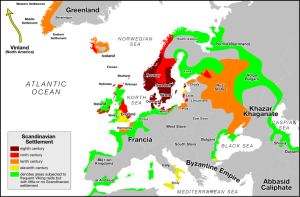
The Romano-Britons in present-day England and Wales faced a serious problem when the Romans left Britain. The Romans had protected the British for four hundred years, and now they were leaving. And the reason they were leaving was that hostile tribes were attacking from all directions. When the Romans abandoned them, it was a desperate situation for the Celts who were left behind in Britain. What could they do to protect themselves against attack?

It seems likely that the Anglo-Saxons were originally invited to help protect the Romano-British against the Picts, a Celtic tribe which was invading from present-day Scotland. The Anglo-Saxons were given land as a reward and they ended up staying. There followed a period of expansion as the Germanic-Scandinavian tribes moved in great numbers into their new homeland. No one is sure how much fighting took place between the Anglo-Saxons and the British Celts. It is also unclear how easy it was for the British Celts to merge with the developing Anglo-Saxons. In any case, by 800 AD, Christian Anglo-Saxon kingdoms were well-established and a new hybrid Germanic-Scandinavian (prototype English) language was developing in present-day England.

The old Anglo-Saxon words provided a foundation for the developing English language, but that was by no means the end for the user-friendly global language we know today. The end of the ninth century was to be the beginning of the Viking Age, and the Anglo-Saxons were hit very hard by their Scandinavian cousins.

England was basically shared between Anglo-Saxons and Vikings by the end of the ninth century, so the Anglo-Saxons had quickly lost half the land they took four hundred years to acquire.

In school, British children all hear the story of the Saxon King, Alfred the Great, who was running away from the Vikings. The story goes that he was so desperate and worried that he burned some cakes he was told to look after. However, Alfred recovered and eventually managed to defeat the Vikings.

Alfred the Great’s army finally defeated the Vikings at the battle of Edlington in 878 AD. As a condition on their surrender, the Vikings had to promise to convert to Christianity. However, this was by no means a final defeat for the Vikings. Indeed they continued to be highly influential in British history. One could even argue that the Vikings actually created the idea of England because they forced the Anglo-Saxons to unify in order to protect themselves.

And the Vikings certainly did not disappear from the scene. It is true that the newly united English kingdom quickly expanded and the Viking lands were swallowed up in this united England. However, the Vikings conquered England again rather quickly and, in 1013, the Viking king Sweyn Forkbeard became king of a north sea empire that included Denmark, Norway, and the whole of England. He was succeeded by his son, Cnut, in 1016.

Interestingly, the rule by the Viking King Cnut is remembered affectionately by the English because he brought a welcome peace to England. He is also remembered as a very wise king. All British schoolchildren hear the story of how he demonstrated the limits of a king’s power by trying to command the sea to retreat. The sea didn’t, and Cnut got wet!

It wasn’t until 1042 that an Anglo-Saxon king returned to the English throne when Edward (the Confessor) succeeded Cnut’s son Harthacnut. Only twenty four years later, in 1066, the Norman French successfully invaded England and put an end to Anglo-Saxon rule altogether. In fact, the Anglo-Saxons under the Normans were second-class citizens and French, not English, was the language of power and prestige.
